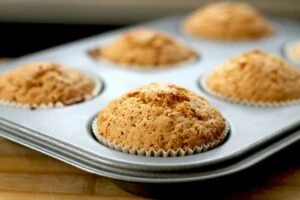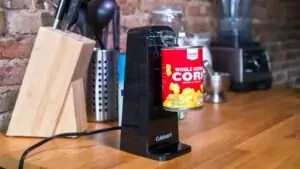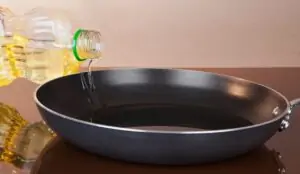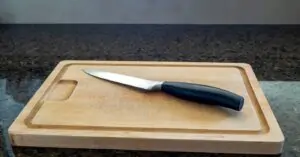If you’ve ever juiced celery, you know how finicky it can be. Small pieces of celery can sometimes find their way into your juice which can be an unpleasant surprise.
That’s why we’ve taken the time to list the best juicers for celery so that you don’t have to find small pieces of celery in your juice ever again.
Quick View
Top Recommended Juicer: Omega J8006 Nutrition Center Masticating Juicer
Best Budget Juicer: Aobosi Slow Masticating Juicer
Best Premium Juicer: Omega Vertical Slow Masticating Juicer
1. Omega J8006 Nutrition Center Masticating Juicer
The Omega J8006 masticating juicer is our top recommended celery juicer. It juices the celery slowly and produces very dry pulp, which is exactly what you want in a juicer. When you have dry pulp, you know that you have extracted all the water (juice) from the vegetable.
The juicer machine runs at 80 revolutions per minute (RPM) which is perfect for juicing celery. This is what puts it at the top of our list. The chute has a smaller diameter than most centrifugal juicers, so you’ll need to make sure you cut your fruits and vegetables into smaller pieces when you use this juicer for anything other than just celery.
The Omega juicer parts are dishwasher-safe, making cleanup quick and easy when you’re done. Plus, it comes with a 15-year manufacturer’s warranty which is almost unheard of for kitchen appliances.
For the efficiency and quality of this Omega juicer, it’s our favorite on the list.
Pros:
- Easy to clean
- Efficient
- Produces dry pulp
- Compact
Cons:
- Slightly pricey
- Auger is made of plastic and is not as durable as the other juicer parts
2. Aobosi Slow Masticating Juicer
The Aobosi slow masticating juicer is the best juicer for celery for those who don’t want to spend a lot of money. It’s a quality juicer that doesn’t break the bank.
Like the Omega J8006, it spins at 80 RPM, ideal for juicing celery. This is the best masticating juicer because it creates very dry pulp and will extract more than 20% more juice than other juicers. This means an additional 30% in vitamins and minerals.
This juicer machine has intelligent protection chips that cause the celery juicer to stop after it has run for 20 consecutive minutes. This keeps the motor from getting overheated since it is a slow juicer. If any fruit or vegetable gets stuck in the juicer, it has a reverse function that will get the produce unstuck from the juicer.
All of the parts of this slow juicer are removable and dishwasher safe, and it’s extremely quiet at less than 60 decibels. So, you won’t disturb anyone in the house when making your fresh celery juice.
Pros:
- Affordable
- Large juice container
- Large pulp container
- Quiet
- Easy to clean
Cons:
- Small chute
3. Omega Vertical Slow Masticating Juicer
The Omega vertical slow masticating juicer is our pick for the best premium juicer because of how much juice it can produce in a short amount of time for a masticating juicer.
It has a dual-edge auger that produces more juice than other models and breaks down the pulp so that you don’t lose as many nutrients from the fibers that you do in some juicers. This allows you to get the maximum amount of nutrients from the fruits and vegetables you juice.
This vertical juicer has an extremely low 43 revolutions per minute (RPM), making it extremely efficient in juicing celery. An anti-clog feature allows you to put the juicer in reverse if the produce becomes stuck.
For cleaning, this celery juicer has an auto-clean feature that will keep the screen clear when juicing, and it has a no-drip spout that can be closed while juicing. All of the parts are removable and dishwasher-safe.
This vertical juicer is backed by the Omega 15-year manufacturer’s warranty if anything should go wrong with the juicer.
Pros:
- Low 43 RPM for maximum efficiency
- Anti-clog feature
- Auto-cleaning
- Dishwasher-safe
- Produces nutrient-rich juice
Cons:
- Pricey
- Even though it is auto cleaning and dishwasher safe, not all parts are easy to wash and may prove to be time-consuming
4. Amzchef Slow Masticating Juicer
The Amzchef slow masticating juicer is a great juicer that comes in various colors for you to choose from (if personalizing kitchen gadgets is your thing). It includes a juice cup and pulp container to fill when juicing.
One of the things we liked most about this juicer is that you can buy different attachments for the juicer to do different functions. You can attach a meat grinder attachment and a slicer/shredder attachment to the juicer. This gives you more than one option for using the juicer.
It produces very dry pulp with juice that is minimally oxidized and packed with nutrients. Oxidation is only around 3% with this juicer.
All of the components of this best celery juicer option are removable and dishwasher-safe for easy cleanup.
Pros:
- Easy to use
- Reverse function
- Attachments available for slicing/shredding and grinding
- Minimal oxidation
Cons:
- The chute can easily be broken if not careful
5. Megawise Pro Slow Masticating Juicer
The Megawise Pro slow masticating juicer has a “soft mode” perfect for celery. When on soft mode, it juices between 50 and 60 RPM for slow and efficient juicing to produce between 88% and 95% juice from the celery. This leaves you with a very dry pulp which is exactly what you want when juicing. The “hard mode” is best for denser and thicker fruits and vegetables. Just because you’re purchasing this juicer for celery doesn’t mean it’s only for celery.
It includes two containers – one for juice and one for pulp. Both containers are dishwasher-safe, as well as the other components of the juicer. It comes with a convenient cleaning brush included for you to easily clean the juicer when you’re finished.
Megawise includes a full product warranty after registering the product. If your juicer needs replacing, they will provide a full replacement as long as you have registered the product.
Pros:
- Slow, hard, and reverse mode functions
- Juice and pulp containers included
- Dishwasher-safe
- Cleaning brush included
- Full product warranty once registered
Cons:
- Small chute
What Is a Masticating Juicer?
A masticating juicer is also known as a slow juicer or a cold juicer because it doesn’t use very much energy (heat) to juice.
A masticating juicer uses an auger to juice fruits and vegetables slowly at very low revolutions per minute (RPM).
The auger slowly crushes the fruit or vegetable, separating the pulp from the juice. The pulp created from a masticating juicer is often drier than with other types of juicers.
Because they use less energy and move at less RPM, they are often quieter than centrifugal juicers. Centrifugal juicers use a lot of power to spin the pulp and produce juice. This can be loud and messy, especially if the centrifugal juicer you’re using only has one speed.
Masticating juicers are designed to slowly crush the fruits and vegetables to create as much juice as possible using as little power as possible. This process can be slow, but it’s worth it, especially when juicing celery.
A masticating juicer also creates juice that has very little froth or foam. Froth is produced when fruits and vegetables are juiced using high energy, and there are some fruits and vegetables that will produce froth more than others. Tomatoes and pineapples, for example, almost always produce foam when juiced. Because a masticating juicer runs at very low speeds and RPM, it produces very little froth.
Why Is a Masticating Juicer Good for Celery?
A masticating juicer is good for celery because it crushes the celery so slowly that it doesn’t cause small pieces of celery to end up in your juice.
A centrifugal juicer chops and spins the celery so fast that some small pieces of celery can inevitably find their way into your juice which can be an unpleasant surprise.
You can use a centrifugal juicer for celery, but you’re extremely likely to find small pieces of celery in your juice as opposed to using a masticating juicer for your celery.
Another reason that a masticating juicer machine is good for celery is because of how many nutrients are preserved using a masticating juicer. A masticating juicer produces very little oxidation and can create 30% more nutrient-rich juice than a centrifugal juicer.
What Is Oxidation?
Have you ever noticed that your apple turns brown within minutes of slicing it open? That’s oxidation. Oxidation occurs when cut fruits and vegetables are exposed to oxygen, which happens when juicing.
Just because the fruits and vegetables are in liquid form and not solid form doesn’t mean there won’t be oxidation. There will be, and it won’t be as visible as an apple turning brown right before your eyes.
This is why minimizing oxidation is important. The less oxidation that occurs when juicing means that your juice will stay fresh for longer, but it also means that more nutrients will remain in the juice.
During oxidation, fruits and vegetables lose nutrients, and the same thing happens in juice. Less oxidation means maximum nutrients, which is exactly what you want when juicing.
How to Prepare Your Produce for a Masticating Juicer
Before you do anything, you’ll need to thoroughly wash your produce. The best way to do this is to place your produce in a colander and rinse it thoroughly. This will remove all of the dirt that has collected on the produce.
A masticating juicer will have a smaller chute that isn’t designed to fit large, whole fruits or vegetables. For this reason, you’ll need to chop your produce down to smaller pieces so it will fit in the chute of the juicer.
Simply get a plastic cutting board and peel your fruits and vegetables, if needed, and cut them with a sharp knife down to a size that will fit in the chute of the juicer.
Make sure that you don’t shove your produce into the chute, or it could break. Many masticating juicers have plastic chutes that can be broken easily, so always cut your produce into smaller pieces and gently feed them into the juicer.
Best Juicer for Celery Buying Guide
Now that you’ve seen some of the best celery juicers and you know a little bit more about masticating juicers and why they are good for extracting juice from celery, it’s time to talk about what to look for when buying the best celery juicers.
Speed and Efficiency
The speed and efficiency of the masticating juicer is arguably the most important feature to consider when choosing the best juicer for celery. The juicer will need to be slow and use as little heat as possible so that no pieces of celery end up in your fresh juice.
You will also need to make sure the juicer will produce dry pulp. If users say the juicer produces wet pulp, then you know the juicer isn’t squeezing out as much juice as it should, leaving you with more waste than you should have.
We recommend choosing a juicer with no more than 80 RPM on the lowest setting. Most masticating juicers only have one speed, but some of them have two speeds or two modes (like the “soft mode” and “hard mode” in the Megawise juicer above).
A juicer that uses high energy will crush the fruits and vegetables and potentially leave more wet pulp behind. What’s more, a high-energy juicer can produce oxidized juice, which will spoil faster and lose many nutrients in the process.
You should choose a juicer that has low speed and energy so that you get more fresh juice with little oxidation.
Pulp and Juice Containers
Not all juicers come with a pulp and juice container. This means you’ll have to use your own containers to catch the pulp and juice. You don’t always have to use a pulp container to catch the pulp. It can extract to the counter below, but this can be messy.
We recommend choosing a juicer that includes a pulp and juice container so that you don’t have to worry about providing your own.
Also, make sure the containers you use are dishwasher-safe for easy cleanup.
Self-Cleaning Mode
Some juicers come with a self-cleaning mode that will keep the juicer clean as it works. This doesn’t mean that you won’t have to clean the parts of the juicer when you’re finished. You’ll still need to wash the components in a dishwasher or by hand.
Instead, the self-cleaning mode will keep the screen of the juicer clean so that you don’t have to work as hard to clean the juicer as you would without it.
Dishwasher-Safe Parts
A juicer with dishwasher-safe parts will make it quick and easy to clean up. You can place all parts in the dishwasher to clean; however, some masticating juicers contain plastic pieces that aren’t recommended for dishwashing. You’ll need to wash these by hand.
The good news is that since masticating juicers work so slowly, there is less mess, making it easier to wash the pieces by hand if you need to. Before placing any of the pieces in the dishwasher, make sure they are listed as dishwasher-safe by the manufacturer. If they’re not, you’ll need to wash them by hand.
FAQ
How long is celery juice good for?
Celery juice can be stored for up to 72 hours in the refrigerator before it needs to be consumed, used, or thrown out. It will need to be sealed to slow the oxidation process. Even though a masticating juicer produces little oxidation, oxidation will still occur, so sealing the juice will slow the oxidation process down.
It’s always best to drink celery juice within the first 20 minutes of being produced, but you can seal it and store it in the refrigerator for up to 72 hours if needed.
What are the benefits of celery juice?
There are many benefits of celery juice. Celery juice is packed with vitamins A and K, potassium, and folate. Drinking celery juice can help fight autoimmune diseases, reduce bloating, and flush out toxins in the liver. Celery and fresh celery juice is also great for increasing antioxidants in the body. It can promote weight loss and improve your overall health.
What part of the celery can I juice?
You can juice the entire celery stalk, but the leaves of the celery stalk can turn your juice bitter. If you’re looking to get as many nutrients from your celery juice as possible, you should consider juicing the celery leaves. This will ensure you get the maximum amount of vitamins and minerals from your celery juice.
However, if you’re new to juicing celery, you may want to avoid juicing the celery leaves because they can make your juice bitter.
If you don’t want to juice the celery leaves, don’t throw them out. You can add them to a salad so that you get the vitamins and minerals from the celery without having to drink them.
Conclusion
Hopefully, this guide has helped you know which juicers are the best for celery and why. For more information about juicing, check out our ultimate guide to juicing where we discuss some of the best centrifugal juicers and why we chose them.











